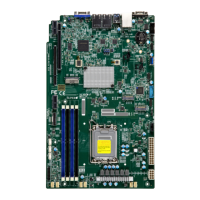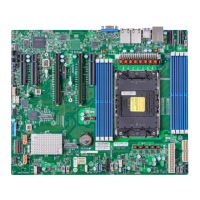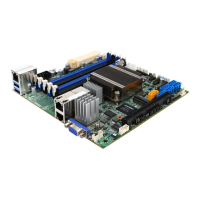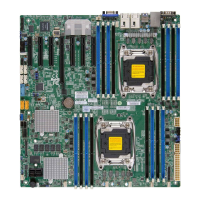17
Chapter 1: Introduction
Motherboard Features
Peripheral Devices
• Two USB 2.0 ports on the rear I/O panel (USB0/1, Type-A)
• One front accessible USB 2.0 header with two USB connections (USB2/3)
• One front accessible USB 3.2 Gen. 1 header with two USB connections (USB4/5, 5Gb)
• One internal USB 3.2 Gen. 1 connector (USB6, 5Gb, vertical Type A)
• Three USB 3.2 Gen. 2 ports on the rear I/O panel (USB7/8/9, 10Gb, Type-A)
• One USB 3.2 Gen. 2x2 port on the rear I/O panel (USB10, 20Gb, Type-C)
• One front accessible USB 3.2 Gen. 2x2 20-pin header with one USB connection (USB11, 20Gb)
BIOS
• 256Mb AMI BIOS
®
SPI Flash BIOS
• ACPI 6.0, Plug and Play (PnP), BIOS rescue hot-key, riser card auto detection support, and SMBIOS 3.0 or later
Power Management
• ACPI power management
• Power button override mechanism
• Power-on mode for AC power recovery
• Wake-on-LAN
• Power supply monitoring
System Health Monitoring
• Onboard voltage monitoring for +12V, +5V, +3.3V, CPU, Memory, VBAT, +5V stdby, +3.3V stdby, +1.8V PCH, +1.05V PCH,
CPU temperature, VRM temperature, PCH temperature, system temperature, and memory temperature
• 5 CPU switch phase voltage regulator
• CPU thermal trip support
• Platform Environment Control Interface (PECI)/TSI
Fan Control
• Single cooling zone
• Multi-speed fan control via onboard Super I/O
• Five 4-pin fan headers
System Management
• Trusted Platform Module (TPM) support
• SuperDoctor® 5
• Chassis intrusion header and detection
Note: Please connect a cable from the Chassis Intrusion header at JL1 to the chassis to receive an alert.
LED Indicators
• BMC_HB_LED
• CATERR_LED
• Power LED
• UID LED (X13SAE-F, IPMI only)
Note: The table above is continued on the next page.

